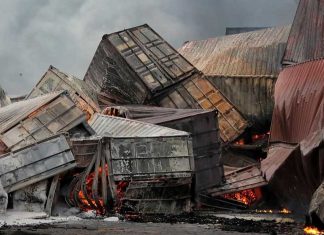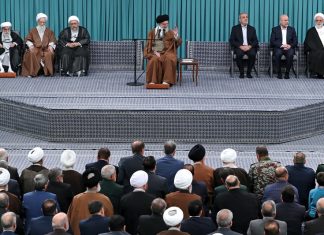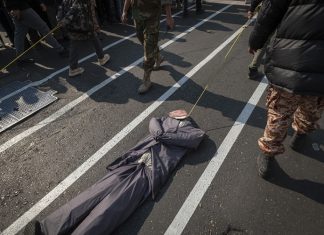A large segment of the population of the Iranian capital, Tehran, might become infected with coronavirus by Nowruz (the Iranian New Year on Marchch 20), according to Dr. Massoud Marchdani, a member of the Iranian National Influenza Center.
As of March 9, the Novel Coronavirus COVID-19 had infected 7,161 people and claimed 237 lives in Iran. Most of the victims were from Tehran and Qom, where the first cases of the virus were reportedly discovered.
“Coronavirus is spreading quickly,” Dr. Marchdani, an infectious diseases specialist, was quoted by the daily Iran as saying on March 5. “One person can infect four other people, which means between 30 to 40 percent of the population of Tehran could contract the virus by late March.”
“The country is facing a coronavirus epidemic,” Dr. Marchdani warned. “We urge everyone to avoid the customary Nowruz get-togethers, cancel their trips, and cover their hands when using public transport and cash machines. Coronavirus can survive on a person’s clothing for two hours. People should hang their clothes in a separate closet immediately after getting home.”
Speaking to reporters on March 4 in Vienna, Michael Ryan, the head of the World Health Organization’s emergency program, said: “Doctors and nurses in Iran have concerns they do not have enough equipment, supplies, ventilators, respirators, oxygen. Those needs are more acute for the Iranian health system then they are for most any other health system.”
In a letter to Iran’s Minister of Health and Medical Education Saeed Namaki, the director of the Medical Council of the Islamic Republic of Iran (IRIMC), Dr. Mohammad Reza Zafarghandi, warned about the shortage of supplies vital in the fight against the spread of coronavirus.
[aesop_image img=”https://kayhanlife.com/wp-content/uploads/2020/02/2020-02-24T115953Z_107265595_OWANAPAAVIDEO2020022420810213_RTRMADP_BASEIMAGE-960X540_ANADOLU-IRAN-CORONAVIRUS.jpg” panorama=”off” credit=”REUTERS./” align=”center” lightbox=”on” captionsrc=”custom” captionposition=”left” revealfx=”off” overlay_revealfx=”off”]
“Private practices and clinics specializing in internal medicine and respiratory and infectious diseases are treating patients who suffer from respiratory ailments and others infected with coronavirus,” Dr. Zafarghandi said in his letter, which was published by the Tehran-based Shafaonline health news website on March 4. “They are all facing a shortage of essential medical, health, and hygiene supplies such as masks.”
Abdolkarim Hosseinzadeh, the Majlis (Iranian Parliament) deputy representing Oshnavieh and Naghadeh electorates in the northwestern province of West Azerbaijan, tweeted: “Ineffective policies and failure to inform the public about coronavirus has caused dead bodies to pile up in Qom [140 kilometers south of Tehran.] It has also concerned people of Rasht [capital of the northern province of Gilan].”
“You [authorities] have not quarantined the cities,” Mr. Hosseinzadeh added. “We are amid an epidemic. Authorities must make self-isolation mandatory in Qom and Rasht and encourage people to stay home. We must not become the world record-holder for the number of coronavirus deaths.”
“Coronavirus epidemic will last until the end of April,” Mehrdad Baouj Lahouti, Majlis deputy representing Langrud electorates in Gilan, said in an interview with the Iranian Labor News Agency (ILNA) on March 5. “We must plan for the post-coronavirus period.”
On the same day, ILNA also spoke to Abolfazl Hassanbeigi, a member of the Majlis’ Committee on National Security and Foreign Policy, who said: “Authorities must take the threat posed by coronavirus seriously. We will face a massive epidemic if we vacillate or, in some situations, adhere to rigid religious prejudices.”
“The world may not care about an epidemic in the Islamic Republic,” Hassanbeigi argued. “They believe that Iran will be forced to ask for outside help once the health crisis has reached a critical point, or suffer terrible consequences.”
“People would not have traveled from Tehran and Qom to other parts of the country if they had been given accurate information. It would have reduced the health risk to the public.” Hassanbeigi noted. “Some TV programs have trivialized and even ridiculed the entire event.”
“Majlis is closed because nine people have contracted the virus, unfortunately,” Hassanbeigi said. “The virus would not have spread to other provinces if we had shut down cities across the country for a week. For instance, two people from my Damghan constituency, in the northern province of Semnan, who had traveled to Qom, infected 12 others after returning home, one of whom sadly died.”
“Coronavirus epidemic is not a security problem,” Hassanbeigi explained. “It is rather a health and medical issue. Coronavirus is not the Taliban, ISIS, or Al-Nusra Front. It is a disease which, if handled correctly, can be treated the same as influenza. We are, however, too relaxed about it.”
Seyyed Ali Hosseini, the Friday prayers leader of Borujerd, in the western province of Lorestan, released a statement on March 4, criticizing the Ministry of Health and Medical Sciences for identifying the holy city of Qom as the place where coronavirus originated.
“Qom seminary and the clerics have been maltreated. They did not receive accurate information about the spread of the disease. That is unforgivable. Are the medical researchers certain that the virus originated in Qom?” the statement said. “Several media outlets have reported that an Arab businessman and his Chinese wife who visited Qom in January carried the virus with them. Even if true, it still did not warrant the media to tell the public that the seminary and the holy city of Qom were responsible for the coronavirus outbreak.”
[Translated from Persian by Fardine Hamidi]





